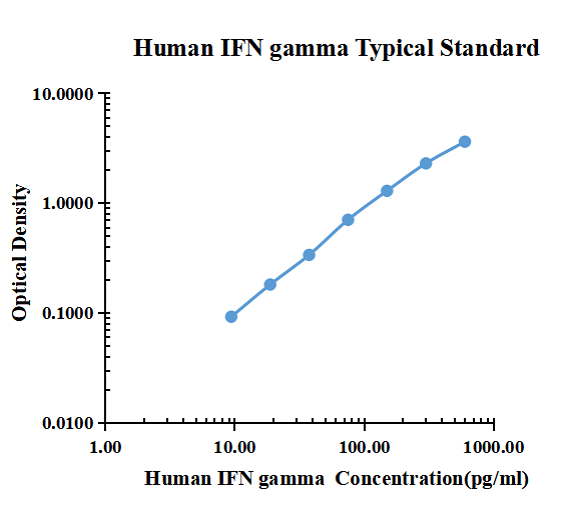Human IFN-gamma DTSet enzyme-linked immunoassay kit
| Specification | 96*5 Test;96T*15 Test |
|---|---|
| Standard Curve Range | 9.38 pg/ml-600pg/ml |
| Standard Curve Gradient | 7 Points/3 Folds |
| Number of Incubations | 2 |
| Detectable sample | Liquid phase sample of soluble substances. For example: serum, plasma, cell culture supernatant, tissue grinding liquid, etc. |
| Sample Volume | 50 μl |
| Type | Not Ready-to-Use |
| Test Duration | 120min |

| pg/ml | O.D. | Average | Corrected | |
|---|---|---|---|---|
| 0.00 | 0.0133 | 0.0117 | 0.0125 | |
| 9.38 | 0.1031 | 0.1072 | 0.1052 | 0.0927 |
| 18.75 | 0.1913 | 0.1975 | 0.1944 | 0.1819 |
| 37.50 | 0.3300 | 0.3718 | 0.3509 | 0.3384 |
| 75.00 | 0.7144 | 0.7221 | 0.7183 | 0.7058 |
| 150.00 | 1.2980 | 1.3150 | 1.3065 | 1.2940 |
| 300.00 | 2.2590 | 2.3650 | 2.3120 | 2.2995 |
| 600.00 | 3.6480 | 3.6260 | 3.6370 | 3.6245 |
Product Features
- Optimized capture and detection antibody pairings with recommended concentrations save lengthy development time
- Development protocols are provided to guide further assay optimization
- Assay can be customized to your specific needs
- Economical alternative to complete kits
Kit Content
- Capture Antibody
- Detection Antibody
- Recombinant Standard
- Streptavidin conjugated to horseradish-peroxidase (Streptavidin-HRP)
Other Reagents Required
DTSet Ancillary Reagent Kit (5 plates): containing 96 well microplates, plate sealers, substrate solution, stop solution, plate coating buffer (PBS), wash buffer, and assay buffer.
- 96 well microplates: YOUKE Life, Catalog # DSEP01. Plate Sealers: YOUKE Life, Catalog # DSSF01.
- Coating Buffer: 137 mM NaCl, 2.7 mM KCl, 8.1 mM Na2HPO4, 1.5 mM KH2PO4, pH 7.2-7.4, 0.2μm filtered . YOUKE Life, Catalog # DSCB01.
- Blocking Buffer: YOUKE Life, Catalog # DSBB01.
- Wash Buffer: 0.05% Tween® 20 in PBS, pH 7.2-7.4. YOUKE Life, Catalog # DSWB01.
- Assay Buffer: 0.5% BSA,0.05% Tween® 20,PBS Solution.YOUKE Life, Catalog # DSAB01
- Substrate Solution: Tetramethylbenzidine. YOUKE Life, Catalog # DSTS01.
- Stop Solution: 0.5mol/ml H2SO4. YOUKE Life, Catalog # DSSS01.
Product Data Sheet
Background: IFN-gamma
Interferon-gamma (IFN-gamma), also known as type II or immune interferon, exerts a wide range of immunoregulatory activities and is considered to be the prototype proinflammatory cytokine. Mature human IFN-gamma exists as a non-covalently linked homodimer of 20-25 kDa variably glycosylated subunits. It shares 90% amino acid (aa) sequence identity with rhesus IFN-gamma, 59%‑64% with bovine, canine, equine, feline, and porcine IFN‑ gamma, and 37%‑43% with cotton rat, mouse, and rat IFN-gamma. IFN-gamma dimers bind to IFN-gamma RI (alpha subunits) which then interact with IFN-gamma RII (beta subunits) to form the functional receptor complex of two alpha and two beta subunits. Inclusion of IFN-gamma RII increases the binding affinity for ligand and the efficiency of signal transduction. IFN-gamma is produced by a variety of immune cells under inflammatory conditions, notably by T cells and NK cells. It plays a key role in host defense by promoting the development and activation of Th1 cells, chemoattraction and activation of monocytes and macrophages, up‑regulation of antigen presentation molecules, and immunoglobulin class switching in B cells. It also exhibits antiviral, antiproliferative, and apoptotic effects. In addition, IFN-gamma functions as an anti-inflammatory mediator by promoting the development of regulatory T cells and inhibiting Th17 cell differentiation. The pleiotropic effects of IFN-gamma contribute to the development of multiple aspects of atherosclerosis.

